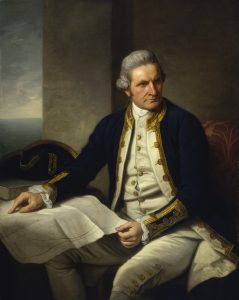As you are coming to the end of your long journey, you’re overwhelmed with the idea that you’ll be home soon, accompanied by warm, familiar faces. However, when you return home, you’re not welcomed by friends and family, but by silence and only the howl of the wind. You look around and not a single soul is in sight. Not one person in your home or in your whole village. A frightening scenario, isn’t it? This was the startling reality that John White and his fellow colonists were faced with when they returned home from their long voyage. His home was none other than the infamous Roanoke Colony.

In 1587, John White led 113 men, women, and children to Roanoke island on behalf of Queen Elizabeth I, in order to establish a New World colony, and claim riches for the queen and people of England.1 The land was somewhat familiar as it had been a previous military outpost.2 However, its first attempt at establishing a colony there had failed. John White and his men were determined not to fail their Queen on this attempt. They especially did not want to fail their investor, Sir Walter Raleigh, like others had in the past. So they went to all extents to make sure their colony’s needs were met.3 The colony seemed to settle well; however, they quickly outgrew supplies, which were essential for the long-term establishment of the colony; so now governor of Roanoke, John White, sailed back to England in order to restock. Upon his arrival in London, he was met with war with Spain and the Spanish Armada, England’s enemy at the time. Storms and many other factors made the return back to Roanoke a long one, one of years, leaving the colonists to wonder when their leader would return.4
Once John White and his men returned, Roanoke was bereft of all its colonists. They recalled that on their way to Roanoke, once already on land, they found a few footprints from Indians.5 However, they made nothing of it at the time. When they reached the village, White came across the letters “CRO” carved on a tree and the word “CROATOAN” carved on a post. Upon further inspection, it seemed that all the houses that the Roanoke Colonist were living in had been dismantled. After seeing this, White was more at ease because he believed that they had relocated to Croatoan, where the Croatoan tribe lived. This was due to the fact that White told the colonists that if they ever relocated, they were to carve the name of their new location somewhere visible. If the move or escape was out of distress, they were also to carve a Maltese cross, but none were in sight. One small thing bothered White though. He had told the colonists to hide his valuables underground, but he found that some were scattered and others were lost. In the end, for a reason unknown, White only looked for the colony one time, but didn’t find them. After this failed attempt, he made no others.6
One question still lingered in the mind of many others: what happened to the Roanoke colonists? It’s said that they were never seen again by Europeans, but there were also many speculated accounts of their whereabouts and fate. In 1608, John Smith wrote in his book that the Indians reported to him of people that looked like him. George Percy, another colonist, reported seeing a white boy with blonde hair among the Indians. Smith later sent two missions towards the south in order to find evidence of the remaining colonists, eventually learning that they were killed.7

Later, a twenty-one-quartz stone was discovered that is believed to have been a “grave marker” for the Roanoke deceased. On the smooth side of the stone was a cross and on the other were passages, speaking of deaths within the colony along with the years.8 As a last matter, in 1612, writer William Strachey reported that the Roanoke Colony did indeed live in harmony with the Chesapeake Indians for twenty-five years. Both the Indians and colonists shared knowledge and lived together until Powhatan, a leader of another Indian tribe called the Powhatan, slaughtered the colonists and the Indians sheltering them in fear that a rival to him would appear from within their tribe. A few of the colonists escaped and were later spared when they were found due to the fact that they worked well with copper, making them valuable. Still many wondered if these were facts or just stories that people wanted to hear.9 In the end, all the evidence points to the fact that the Roanoke colonists are not lost to history, but were rather killed off by brutal Indians. There is no mystery left, it’s just a matter of connecting the dots.
- The Gale Encyclopedia of the Unusual and Unexplained, 2003, s.v. “The Desertion of Roanoke,” by Brad Steiger and Sherry Hanson Steiger; Karenne Wood, “The Roanoke Colony,” South Atlantic Review 77, no. 1/2 (2012): 178-79. ↵
- Lee Miller, Roanoke Solving the Mystery of England’s Lost Colony (London: Pimlico, 2001), 7-9. ↵
- Karenne Wood, “The Roanoke Colony,” South Atlantic Review 77, no. 1/2 (2012): 178-79. ↵
- Lee Miller, Roanoke Solving the Mystery of England’s Lost Colony (London: Pimlico, 2001), 10-11. ↵
- Karen Odahl Kupperman, Roanoke The Abandoned Colony (New Jersey: Rowman & Allanheld, 1984), 133-135. ↵
- Karen Odahl Kupperman, Roanoke The Abandoned Colony (New Jersey: Rowman & Allanheld, 1984), 136-137. ↵
- Karen Odahl Kupperman, Roanoke The Abandoned Colony (New Jersey: Rowman & Allanheld, 1984), 137-139. ↵
- Haywood J. Pearce, “New Light on the Roanoke Colony: A Preliminary Examination of a Stone Found in Chowan County, North Carolina,” The Journal of Southern History 4, no. 2 (1938): 148-150. ↵
- Karen Odahl Kupperman, Roanoke The Abandoned Colony (New Jersey: Rowman & Allanheld, 1984), 139. ↵



114 comments
Mariah Cavanaugh
What a fantastic mystery! The history of Roanoke sounds almost like an M. Night Shyamalan Movie. Your opening paragraph did a great job of setting up the ominous feeling that John White must have felt when returning to Roanoke. Like with any good mystery story you did a wonderful job of bringing it to a close. I would be interested to know what trigged the attack from the Powhatan.
Emmanuel Leonard
No matter how you look at it, over 100 colonists up and vanished without a trace. I think that is the greatest mystery of all. The fact that they gave two clues and yet were still never definitively found is what interests me the most. I’ve read about possibilities of cannibalism as well as theories of alien abduction, but to me I think the most plausible idea would be that the settlers relocated to Croatoan Island (now Hatteras Island), which was just south of the Roanoke colony. The reason for this is the fact that settlers had been to Roanoke once before, where they befriended a Croatoan Indian named Manteo, who had previously helped them through the winter.
Felicia Stewart
This is article is very capturing. From the very beginning it immediately made me want to continue reading to learn more on the topic. I first heard about the Roanoke Colony about a year ago and it was always intriguing to me, however, I never really researched much more into it. The fact an entire group of people could disappear, vanish, and only leave very little tracks and signs behind is very astonishing. Also, John White returning to find no one there must have been a shock. This was a great article and was very informative.
Hali Garcia
This is a fascinating article. When I read about Roanoke from the textbook I became very interested. I wanted to know what exactly happened to the colonists. It must have been completely baffling to come back and not find anyone. This was a mystery that really kept me interested after reading this article because now I know that they had a way of sending messages if something had happened but they only left one saying where they went. I am glad they were able to find out what happened later on.
Abigail Lopez
I found this article to be fascinating. It’s understandable how a whole colony can vanish within the time John White was away, but the fact that there were only little traces of them is shocking. I found it disheartening to know that White never tried searching for them after his only and only attempt failed. When he sailed all the way back to England to gather supplies for his colonists it demonstrated that he was a courageous leader, but when he quickly cancelled the search after being unsuccessful it proved otherwise.
Bictor Martinez
I have read about the story of Roanoke Island before. It is insane to think that such a large number of people can just vanish leaving only small traces. I can only imagine what John White must have felt like when he returned to a colony he was building only to find nobody there. I would have been terrible frightened. If it was truly the Indians that slaughtered them all then it could have been because of how the people from England came and took over their land without permission, however we will never know the truth.
Honoka Sasahara
I like the beginning part that attracts readers’ minds. The story of Roanoke was so interesting as well, which made me seek knowing the end of this colony. It is totally weird that there was no clue to the mystery. I hope that someday it would be revealed and we’d know what happened actually and to where they were gone.
Mariah Cavanaugh
Roanoke is a weird chapter in the history of early US colonization. I like that your article walks through some of the possible fates of the Roanoke colonists. In the end, though we will never truly know, I don’t find this as surprising as some people do. There was no method of tracking people at this time. Further, this was a small group left to fend for themselves for years. It seems likely they tried to make it somewhere else when it was clear their leader wasn’t going to return in time to help them. Whether they did that successfully, we will never know, but looking at the challenges of the time it seems likely they perished and should be remembered for their bravery in trying to make a new life for themselves.
Mia Stahl
It’s incredible that there still exists such profound mysteries in the history of our nation. Especially the foundation of the history we’ve built our country on. It is eerie and almost unbelievable that such an important part of our history can remain to this day a mystery of incredible size. When considering the fact that these people disappeared without any apparent trace it almost makes sense because of the lack of technology and the need to rely on word of mouth. But living with such a large gap in the history of our nation, it feels almost as if we are remiss in the way of the possible interpretations of our history.
William Rittenhouse
This is a very interesting article I never followed up with when we learned about it in high school. I’m sure the tensions were high after knowing how other whites treated Indians. Overall I think they didn’t get along. The whites came over and although some did treat them right, most did not. Taking land and claiming it as their own because they had the power was kind of a bully move. It wouldn’t suprise me if the Indians did slaughter them all.